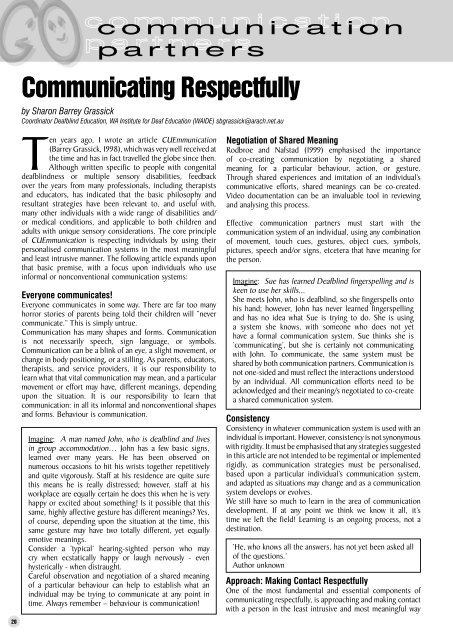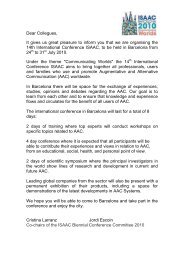May 2008 Edition - agosci
May 2008 Edition - agosci
May 2008 Edition - agosci
Create successful ePaper yourself
Turn your PDF publications into a flip-book with our unique Google optimized e-Paper software.
ccommunicationo m m u n i c a t i o nppartnersa r t n e r sCommunicating Respectfullyby Sharon Barrey GrassickCoordinator Deafblind Education, WA Institute for Deaf Education (WAIDE) sbgrassick@arach.net.auTen years ago, I wrote an article CUEmmunication(Barrey Grassick, 1998), which was very well received atthe time and has in fact travelled the globe since then.Although written specific to people with congenitaldeafblindness or multiple sensory disabilities, feedbackover the years from many professionals, including therapistsand educators, has indicated that the basic philosophy andresultant strategies have been relevant to, and useful with,many other individuals with a wide range of disabilities and/or medical conditions, and applicable to both children andadults with unique sensory considerations. The core principleof CUEmmunication is respecting individuals by using theirpersonalised communication systems in the most meaningfuland least intrusive manner. The following article expands uponthat basic premise, with a focus upon individuals who useinformal or nonconventional communication systems:Everyone communicates!Everyone communicates in some way. There are far too manyhorror stories of parents being told their children will “nevercommunicate.” This is simply untrue.Communication has many shapes and forms. Communicationis not necessarily speech, sign language, or symbols.Communication can be a blink of an eye, a slight movement, orchange in body positioning, or a stilling. As parents, educators,therapists, and service providers, it is our responsibility tolearn what that vital communication may mean, and a particularmovement or effort may have, different meanings, dependingupon the situation. It is our responsibility to learn thatcommunication: in all its informal and nonconventional shapesand forms. Behaviour is communication.Imagine: A man named John, who is deafblind and livesin group accommodation… John has a few basic signs,learned over many years. He has been observed onnumerous occasions to hit his wrists together repetitivelyand quite vigorously. Staff at his residence are quite surethis means he is really distressed; however, staff at hisworkplace are equally certain he does this when he is veryhappy or excited about something! Is it possible that thissame, highly affective gesture has different meanings? Yes,of course, depending upon the situation at the time, thissame gesture may have two totally different, yet equallyemotive meanings.Consider a ‘typical’ hearing-sighted person who maycry when ecstatically happy or laugh nervously - evenhysterically - when distraught.Careful observation and negotiation of a shared meaningof a particular behaviour can help to establish what anindividual may be trying to communicate at any point intime. Always remember – behaviour is communication!Negotiation of Shared MeaningRodbroe and Nafstad (1999) emphasised the importanceof co-creating communication by negotiating a sharedmeaning for a particular behaviour, action, or gesture.Through shared experiences and imitation of an individual’scommunicative efforts, shared meanings can be co-created.Video documentation can be an invaluable tool in reviewingand analysing this process.Effective communication partners must start with thecommunication system of an individual, using any combinationof movement, touch cues, gestures, object cues, symbols,pictures, speech and/or signs, etcetera that have meaning forthe person.Imagine: Sue has learned Deafblind fingerspelling and iskeen to use her skills...She meets John, who is deafblind, so she fingerspells ontohis hand; however, John has never learned fingerspellingand has no idea what Sue is trying to do. She is usinga system she knows, with someone who does not yethave a formal communication system. Sue thinks she is‘communicating’, but she is certainly not communicatingwith John. To communicate, the same system must beshared by both communication partners. Communication isnot one-sided and must refl ect the interactions understoodby an individual. All communication efforts need to beacknowledged and their meaning/s negotiated to co-createa shared communication system.ConsistencyConsistency in whatever communication system is used with anindividual is important. However, consistency is not synonymouswith rigidity. It must be emphasised that any strategies suggestedin this article are not intended to be regimental or implementedrigidly, as communication strategies must be personalised,based upon a particular individual’s communication system,and adapted as situations may change and as a communicationsystem develops or evolves.We still have so much to learn in the area of communicationdevelopment. If at any point we think we know it all, it’stime we left the field! Learning is an ongoing process, not adestination.‘He, who knows all the answers, has not yet been asked allof the questions.’Author unknownApproach: Making Contact RespectfullyOne of the most fundamental and essential components ofcommunicating respectfully, is approaching and making contactwith a person in the least intrusive and most meaningful way20





